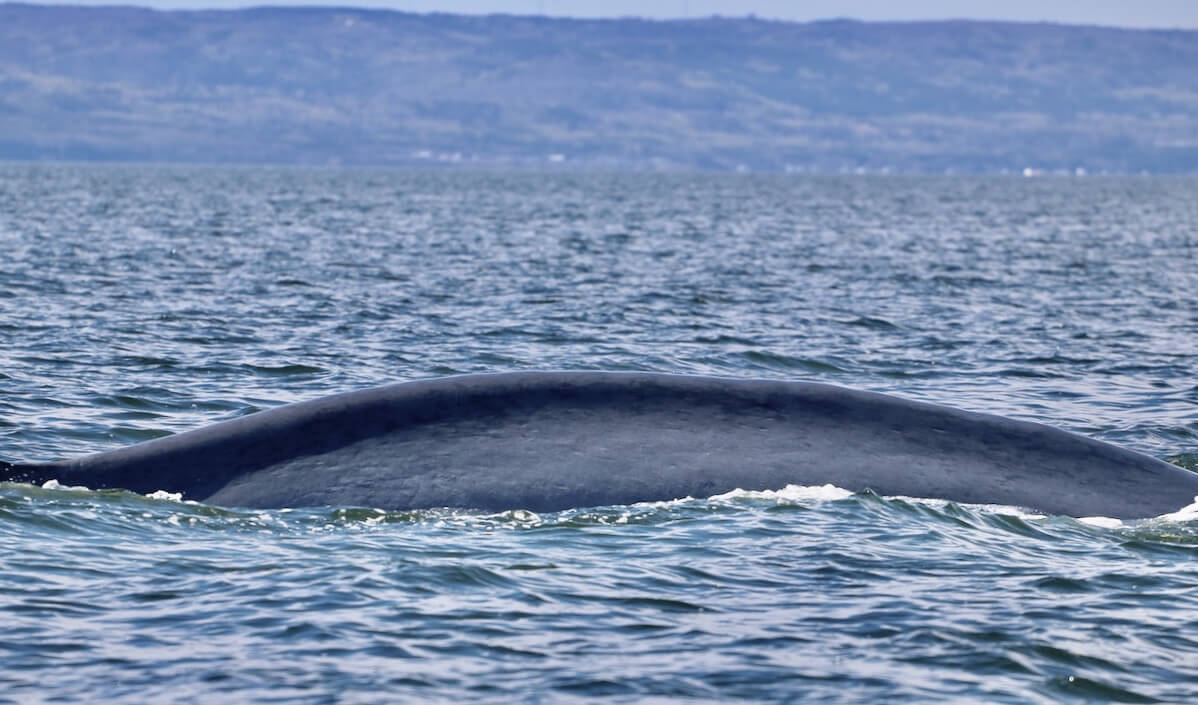Five greyish-blue backs contrast with the still snow-capped Chic-Chocs in the Gaspé. A black back near the bridges of Québec City. White bodies visible under the surface near Saint-Irénée. Up and down the St. Lawrence, whales are drawing the attention of humans, who are seeing them with increasing frequency. A brief roundup of recent sightings…
Breathtaking landscape
Jacques Gélineau, who notably collaborates with the Mingan Island Cetacean Study (MICS) and the Sept-Îles Research and Education Centre, resumed his trips out to sea to document fin whales swimming off Sept-Îles. May 25 was an exceptional day: he encountered five blue whales, four fin whales, three humpbacks – including Tracks with a calf – five or six minke whales and porpoises. And to top it all off, he witnesses a herd of thousands of harp seals. “It’s quite an extraordinary landscape. Our St. Lawrence has so much diversity,” he points out.
Another exceptional landscape is that of the Chic-Choc mountains, whose still snow-capped peaks contrast with the majestic backs of the large rorquals observed off the coast of Matane. MICS collaborator René Roy photographs five blue whales and an equal number of fin whales on May 24. René shares all of his observations in a log that can be consulted here.
Amazing humpbacks
On May 22, opposite Cap-des-Rosiers in the Gaspé Peninsula, a humpback whale uses the propelling force of its tail to hurl its body out of the water. On May 25, a fisherman was also surprised to see a humpback breaching near his boat off Port-Cartier, in Quebec’s Côte-Nord region. This species is truly the champion of aerial acrobatics in the St. Lawrence, closely followed by the minke whale and the white-sided dolphin.
On May 23, once the wind finally stops blowing, the hitherto choppy waters Gaspé Bay grow calm again. A resident of Cap-aux-Os has the pleasure of watching two humpbacks swimming peacefully from her kitchen window.
Another humpback created quite a surprise on May 26, this time in the Québec City region. A fisherman jumped when he heard a whale blowing in close proximity while he was between Saint-Romuald and Québec City. A photographer installed at the Quai des Cageux docks near Québec City also captured the portrait of this vagrant. The presence of a humpback whale in these parts of the St. Lawrence, i.e. the Fluvial Estuary, is highly unusual. Follow her journey in this article.
The pleasure of spotting belugas
Whether in Baie-des-Rochers, Tadoussac or Les Escoumins, observers are always delighted to see the white backs of belugas, or “little crescent moons”, as Bernard Émond would say. In Saint-Irénée, a local resident even had the chance to peer down from her home and observe belugas in their entirety. “They were right under me, below the surface… I could even make out their bodies through the clear water,” she exclaims. A beautiful moment.”
More firsts
For an avid birder in the Haute-Côte-Nord region, belugas and minke whales are now practically part of his daily landscape. But on May 24, he was entitled to his first observation of a harbour porpoise in Les Escoumins. It takes a keen eye to spot the smallest of the St. Lawrence’s toothed whales. A quick breath and down she goes again! The porpoise has already disappeared.
For another observer from Saint-Irénée, the highlight is seeing her first minke whale of the year in her region. “It was doing its feeding manoeuvres and poking its head out to catch the capelin. Simply magical!” In the Charlevoix sector, minke whales occasionally visit when small fish such as capelin abound. And since capelin come close to shore, so do the whales!








